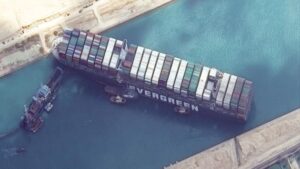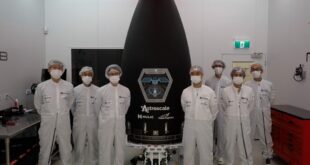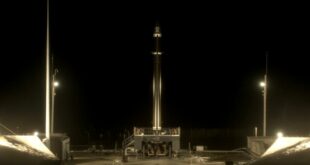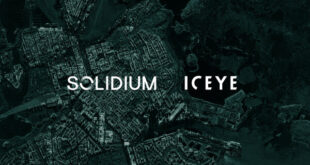by Alyssa Goessler

In March of this year, the giant container vessel “Ever Given” disrupted global commerce when it was lodged into the bank of the Suez Canal for nearly a week. According to Reuters, about twelve percent of total global trade passes through this canal. At the time of the blockage, global trade routes had already been severely impacted by the COVID-19 crisis, making the weight of the blockage all the more pronounced. In addition to generating a slew of blue-ribbon memes, this event produced important lessons learned for the field of space traffic management.
Analogies are often made between the policy spheres of maritime law and space law, given that both pertain to a physical space with no clear regulatory jurisdiction, or perhaps overlapping regulatory jurisdictions. As stipulated by the 1982 United Nations Convention on the Law of the Sea (UNCLOS) the “territorial sea”—that which is the sovereign jurisdiction of a given country—encompasses the twelve nautical miles of coastal waters extending from that country’s shores. Beyond this “territorial sea” lies the “exclusive economic zone” where the coastal country exerts the exclusive right to conduct economic activities, such as the establishment of fisheries and/or mineral resource mining. Beyond this economic zone—which ends at a maximum of two hundred nautical sea miles—lies the high seas. It is the high seas which most resemble near-earth space. While there is disagreement surrounding precisely where space begins from a legal perspective, the Fédération Aéronautique Internationale defines the boundary of outer space at the so-called Karman Line, which is at 100 kilometers above the mean sea level. Most countries accept this as the official demarcation.
The UNCLOS states that “No State may validly purport to subject any part of the high seas to its sovereignty” (Article 89) and that “Every State…has the right to sail ships flying its flag on the high seas” (Article 90.) Similarly, the Outer Space Treaty (OST) stipulates that outer space “is not subject to national appropriation by claim of sovereignty, by means of use or occupation, or by any other means” (Article 2) and that outer space is “free for exploration and use by all States without discrimination of any kind” (Article 1.) Similarities exist not only in the legal sphere but also in the operational sphere. A canal is a human-made waterway channel that boats can pass through. There are no human-made passageways in space, but there are “orbital highways”–bands of orbit that several anthropogenic space objects pass through.
Given these baseline similarities, there is wisdom that may be gleaned from the Ever Given’s temporary obstruction of the Suez Canal.
Lesson One: Public-private collaboration can deliver major benefits
The ship’s owner, a Japanese company, hired two salvage firms from the Netherlands and Japan to refloat the container ship. The firms—SMIT Salvage and Nippon Salvage—worked closely with the Suez Port Authority to free the vessel. Both companies specialize in an array of marine crisis operations, including salvage missions. They benefit from their global networks, maintaining strategic partnerships in several locations across the globe. This enabled them to send salvage teams to the canal faster than the ship’s owner would have been able to send a civil salvage fleet. Further, they brought specialized knowledge to bear which a civil authority, be it ship’s operator or the port authority, would likely have neither the time nor resources to accrue. Astroscale’s forthcoming ELSA-d mission is a signal that the practice of contractual orbital salvage missions may be heading in a similar direction. Astroscale, a Japanese firm that specializes in debris removal, is on track to complete the world’s first commercial debris removal mission. Should it be successful, it could mean that a thriving commercial salvage field of orbital debris removal could be both a) lucrative for private companies and b) resource-smart for civil entities.
Lesson Two: We must observe the environment and align our practices with ecological conditions at hand
The salvage crews worked on a schedule driven by the environmental conditions determined by the tides. In the end, the Ever Given’s saving grace was a full moon, which created a very needed extra few centimeters of tidal flow. Just as the salvage crews and Suez Port Authority aligned their work with the environmental conditions at hand, we must boost efforts to measure and quantify the space environment in order to craft sustainable traffic management mechanisms. Empiricism must be invoked which can similarly inform us of natural space environmental conditions which can aid in orbital salvage practices. To wit, we conserve resources anytime we work along with mother nature and not against her.
Lesson Three (Forthcoming): Liability and insurance are complicated in multinational crises
The Ever Given is owned by a Japanese company, Shoei Kisen Kaisha, and was chartered during the time of the incident by a Taiwanese company named Evergreen Marine. The vessel’s technical management was undertaken by the Bernand Schulte Shipmanagement, a German company, and the ship is registered in Panama. As of early July 2021, the Ever Given has remained impounded as the Suez Canal Authority demands compensation for a) its assistance in the salvage and for b) reputational harm resulting from the blockage. The space policy community should remain focused on the outcome and wait for the release of further details on this process, as it may provide guidance for ascertaining liability in similarly multinational crises in space.
While it is impossible for a spacecraft to permanently or temporarily occupy real estate in space, derelict satellites occupy lanes of space traffic by virtue of their inability to maneuver. This consumption of orbital carrying capacity imposes operational costs on other spacefaring nations who must sacrifice precious fuel in order to avoid the possibility of a collision with the dead and hazardous object. The increase of proliferated low Earth orbit constellations (also known as “mega-constellations”) will only deepen this burden. Constellations rapidly increase congestion and are composed of smaller satellites that are more prone to defect, thereby increasing the population of derelict ASO’s around which other space operators must maneuver.
Given the relative infancy of the field of space law, it is wise to look to analogous incidents in other legal and policy spheres. No cross-domain analogy will be perfect, but identifying conceptual similarities may better equip us to handle novel circumstances in space. Such comparative analyses will enable us to judiciously prepare for and avoid collisions on orbit, lest we fall victim to an orbital Ever Given.

Alyssa Goessler is a third-year graduate student pursuing a dual-degree in Global Policy and Middle Eastern Studies at the LBJ School of Public Affairs and the Center for Middle Eastern Studies at the University of Texas at Austin. Prior to joining the UT community, Alyssa worked for three years in foreign policy in New York City—first, at the Mission of Jordan to the United Nations, and thereafter in the Executive Office of the Council on Foreign Relations. She is a Graduate Research Assistant and Senior Brumley Fellow at the Strauss Center for International Law specializing in space security, safety, and sustainability.
 SpaceWatch.Global An independent perspective on space
SpaceWatch.Global An independent perspective on space




